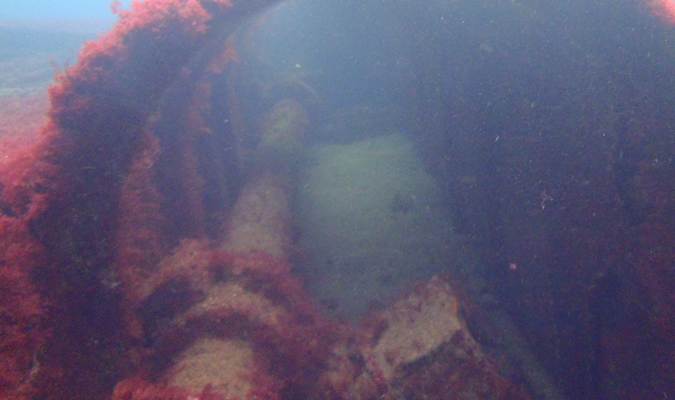SS Emerald Wings
The following presents new data collected as part of a recent Historic Scotland funded project – the Scapa Flow 2013 Marine Archaeology Survey – which aimed to assess the extent and condition of some of the sites around Scapa Flow.
Vessel History
A British steel steamship built as the SS Depute Pierre Goujon by Government Yard, Cherbourg for the French Government, Le Havre in 1920, she was subsequently sold to Soc. Anon. de Nav. "Les Armateurs Français", Havre in 1921 where she served for 13 years. She was then purchased by Union Industrielle & Marit. Soc. Française d'Armement in 1934. Resold the same year to the Greek company Pothitos E. Baikas the SS Depute Pierre Goujon was renamed Nicholas Baikas.
The vessel was only named SS Emerald Wings in 1936 when purchased by Wing Line Ltd. She was requisitioned by the Admiralty in 1940 and was scuttled as a blockship in Skerry Sound on the 5th July 1940. the forward mast and sections of the bow stand clear of the water at all states of the tide. This is not the mast of the SS Elton as described by Ferguson (1985: 30) and Macdonald (1993:118)
Contrary to the records of the 1972 Undermarine Operation survey, which describe the the wreckage as “small but intact, most of the hull dries but it is in a weak state and will soon collapse” the remains of the SS Emerald Wings are more substantial. It is possible that the 1972 surveys are describing the remains of the AC-6 Barge, as with the exception of the mast and some small sections of the bow and stern, the rest of the wreck is submerged.
In 1985 Macdonald (1985: 119) describes the remains as “now well dispersed with boiler showing at low water”, this accurately describes the SS Argyle and is clearly not the SS Emerald Wings. This is further confirmed by the location of the SS Emerald Wings in his map of Skerry Sound (Macdonald 1993: 115).
The site is easily accessible from both north and south shores of Barrier 2, and makes an interesting dive.
Diver Surveys
The wreck lies on a sand bottom, in about 8m – 10m of water. The stern of the vessel is intact with the railings and a pair of bitts visible. A small portion of the stern protrudes from the water at low tide. The steering quadrant which can be seen on the side scan image can be seen underwater, but there is no propeller. Wreckage from the stern is intermingled with debris from the bow of the SS Ilsenstein and the stern of the SS Almeria which all meet in the same area.
Moving forward, the propeller shaft and tunnel can be seen, and there are sections of the aft mast in the surrounding debris. The remains of a triple expansion engine and the engine wheel are still in place although the engine is lying on its side. These are surrounded by several sections of metal grating likely from the engine room walkway. Two Scotch boilers are visible forward of the engine and there is a hatch and davit in the debris.
The bow is quite intact and stands just clear of the water at low tide. An anchor winch lies off the wreck to the port side. The fore and aft holds have been filled with concrete – this was used to sink the vessel during the scuttling.
Side Scan Data
The side scan images in the gallery show the remains of part of the stern and aft hold of the SS Emerald Wings abutting the bow of the SS Ilsenstein and the stern of the SS Almeria. The scanned remains measure 32m long by 8m beam, but the submerged wreckage is more substantial. SS Emerald Wings is oriented east to west, with the bow to the west.
















